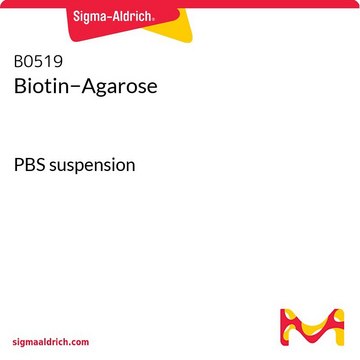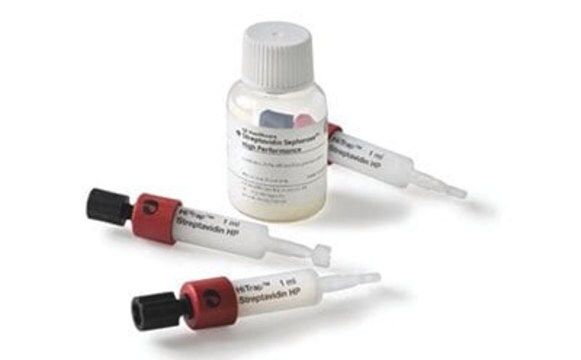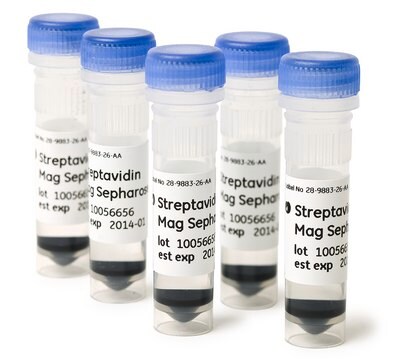STREPMAG-RO
Roche
Streptavidin-Magnetpartikel
suspension
Synonym(e):
Magnetpartikel, Streptavidin
Anmeldenzur Ansicht organisationsspezifischer und vertraglich vereinbarter Preise
Alle Fotos(1)
About This Item
UNSPSC-Code:
12352202
Empfohlene Produkte
Form
suspension
Verpackung
pkg of 10 mL (11641786001)
pkg of 2 mL (11641778001)
Hersteller/Markenname
Roche
Versandbedingung
wet ice
Lagertemp.
2-8°C
Allgemeine Beschreibung
Die Streptavidin-Magnetpartikel sind polydisperse paramagnetische Partikel, die für die schnelle Trennung einer Vielfalt von biotinmarkierten Molekülen entwickelt wurden. Die Partikel werden in einer Suspension geliefert, die 10 mg Partikel pro mL in 50 mM HEPES, 0,1 % Rinderserumalbumin (BSA), 0,01 % Methylisothiazolon, pH 7,4, enthält.
Bindungskapazitäten pro mg Streptavidin-Magnetpartikel:
>= 1800 pmol freies Biotin
>150 pmol biotinmarkiertes Oligonukleotid
>10 pmol biotinmarkiertes dsDNA-Fragment
Bindungskapazitäten pro mg Streptavidin-Magnetpartikel:
>= 1800 pmol freies Biotin
>150 pmol biotinmarkiertes Oligonukleotid
>10 pmol biotinmarkiertes dsDNA-Fragment
Anwendung
Die Streptavidin-Magnetpartikel sind polydisperse paramagnetische Partikel, die für die schnelle Trennung einer Vielfalt von Biotin-markierten Molekülen entwickelt wurden. Die Partikel werden in einer Suspension geliefert, die 10 mg Partikel pro mL enthält. Die magnetische Trennung von Biotin-markierten Molekülen wurde in einem breiten Spektrum von Anwendungen erfolgreich eingesetzt.
Sonstige Hinweise
Nur für die Life-Science-Forschung. Nicht für den Einsatz in diagnostischen Verfahren geeignet.
Signalwort
Warning
H-Sätze
Gefahreneinstufungen
Skin Sens. 1
Lagerklassenschlüssel
12 - Non Combustible Liquids
WGK
WGK 1
Flammpunkt (°F)
No data available
Flammpunkt (°C)
No data available
Analysenzertifikate (COA)
Suchen Sie nach Analysenzertifikate (COA), indem Sie die Lot-/Chargennummer des Produkts eingeben. Lot- und Chargennummern sind auf dem Produktetikett hinter den Wörtern ‘Lot’ oder ‘Batch’ (Lot oder Charge) zu finden.
Besitzen Sie dieses Produkt bereits?
In der Dokumentenbibliothek finden Sie die Dokumentation zu den Produkten, die Sie kürzlich erworben haben.
Kunden haben sich ebenfalls angesehen
Martin Schatte et al.
Bioconjugate chemistry, 27(6), 1484-1492 (2016-05-18)
Enzymes able to ligate biomolecules are emerging tools to generate site-specific bioconjugates. In this study we present a detection and screening method for bioconjugating enzymes which overcomes limitations of analytical methods such as HPLC or MS. These techniques are experimentally
Debolina Ray et al.
Cancer biology & therapy, 13(10), 848-857 (2012-07-13)
Stress treatment generally causes the post-translational modification and accumulation of the p53 protein, although the role of these aspects has not been always understood in relation to this protein's tumor suppressor activity. We analyzed these attributes of p53 in eight
Matthew T Balmer et al.
Cancer biology & therapy, 15(8), 1000-1012 (2014-05-08)
The chemotherapeutic agents doxorubicin (dox) or 5-fluorouracil (5FU) are used to treat cancer cells as they cause irreparable DNA damage, inducing these aberrant cells to undergo cell death. The mediator of this process is presumed to be in part the
Unser Team von Wissenschaftlern verfügt über Erfahrung in allen Forschungsbereichen einschließlich Life Science, Materialwissenschaften, chemischer Synthese, Chromatographie, Analytik und vielen mehr..
Setzen Sie sich mit dem technischen Dienst in Verbindung.












